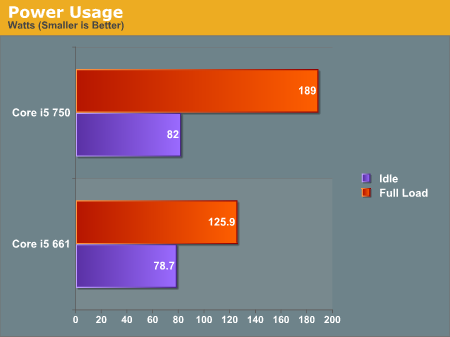The Clarkdale Experiment: Mea Culpa
by Loyd Case on May 4, 2010 1:57 PM ESTWhat About Power?
One of the main points of building a Clarkdale system was power usage. Let’s take a look at power usage differences, first at idle, then full throttle.

Okay, here’s where Clarkdale shines, especially when you dial up the clock speed. At full throttle, the Lynnfield / P55 combination consumes 189W versus 126 for the Clarkdale system. This translates into heat generated as well.
On the other hand, the goal for this system was to build a compact gaming system. Low power usage would have been ideal for, say, a home theater PC with a lower cost graphics card. If this is really a LAN party gaming rig, the added power draw isn’t as big a deal.
If we postulate playing games four hours a day, five days a week, all year round, the difference in power draw translates to 65KWh over an entire year – and that’s a lot of gaming. That translates to $20 or so spread out over the entire year at $0.30 per KWh. In reality, few people run their gaming rigs full throttle four hours a day – even if they’re playing four hours a day.
Anand was Right
The higher cost SKUs of Clarkdale seem overpriced for the performance you get. Given that the true quad core Core i5 750 and the dual core Core i5 661 are roughly priced at parity, Lynnfield is a better deal. Bear in mind that we’ve been running Lynnfield at its default 2.67GHz clock, too. If you overclock, the story just gets better.
Even power usage doesn’t translate to huge savings in our particular usage model. If I were gulding an HTPC, I’d drop down to a lower priced CPU, and a graphics card with less power draw (and costing less.) For a gaming system, though, Lynnfield looks like a much better solution.
Mea Culpa. Mea Maxima Culpa.










45 Comments
View All Comments
fixxxer0 - Tuesday, May 4, 2010 - link
the table comparing the two systems calls the lynnfield an i7 750.hyvonen - Tuesday, May 4, 2010 - link
The colors in most graphs indicating multi-threaded/single-threaded scores are reversed.numberoneoppa - Tuesday, May 4, 2010 - link
:3Shadowmaster625 - Tuesday, May 4, 2010 - link
Why even use a chip that has built-in graphics if you're not using them? That in itself makes it a waste. But the lynnfield is a waste too for gamers. An overclocked E6300 or phenom X2 550 would make much more sense.hyvonen - Tuesday, May 4, 2010 - link
Similarly, if you're building a HTPC rig, why have an overkill graphics card, especially if the CPU (i5-661) already has an HD-capable IGP in it?Those power numbers are superhigh. My i5-670 based HTPC rig idles at 22W, with load around 85W.
jordanclock - Tuesday, May 4, 2010 - link
The article states that the machine would be used mainly for PC Gaming. I think this fits well within the definition of a HTPC, as a video game console could just as easily be considered part of a home theater set up.DanNeely - Tuesday, May 4, 2010 - link
Because Intel's pushed onchip gfx across its midrange line of CPUs. They don't have a dual core Nehalem chip without integrated GFX. Next year when LGA2011 (sandy bridge) replaces LGA 1366 for high end systems and low end core2 chips are replaced with either lower cost LGA1156 (nehalem) or new LGA1155 (sandy bridge) chips they'll have done so across their entire product line.Hopefully by then the GPU switching technology being deployed in a few laptops will have been added to desktop drivers as well for even greater power savings at idle.
TonyB - Tuesday, May 4, 2010 - link
If I were gulding an HTPC, I’d drop down to a lower priced CPU, and a graphics card with less power draw (and costing less.)CSMR - Tuesday, May 4, 2010 - link
And an HTPC doesn't benefit from a discrete graphics card.Taft12 - Wednesday, May 5, 2010 - link
Indeed a discrete graphics card is a hindrance to an HTPC in terms of power usage and heat generation.